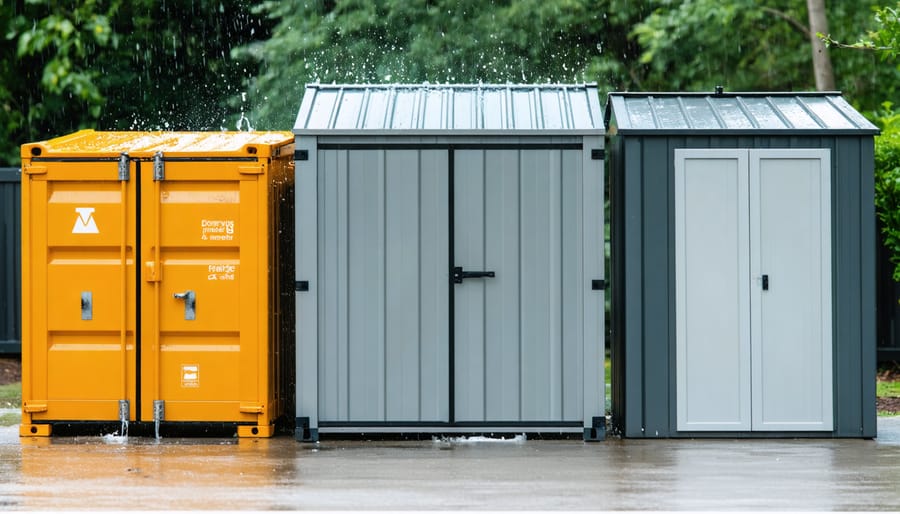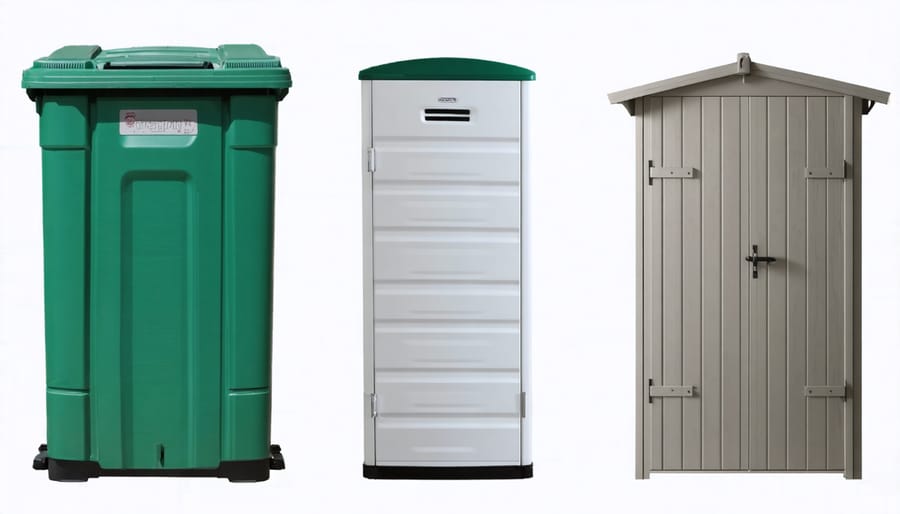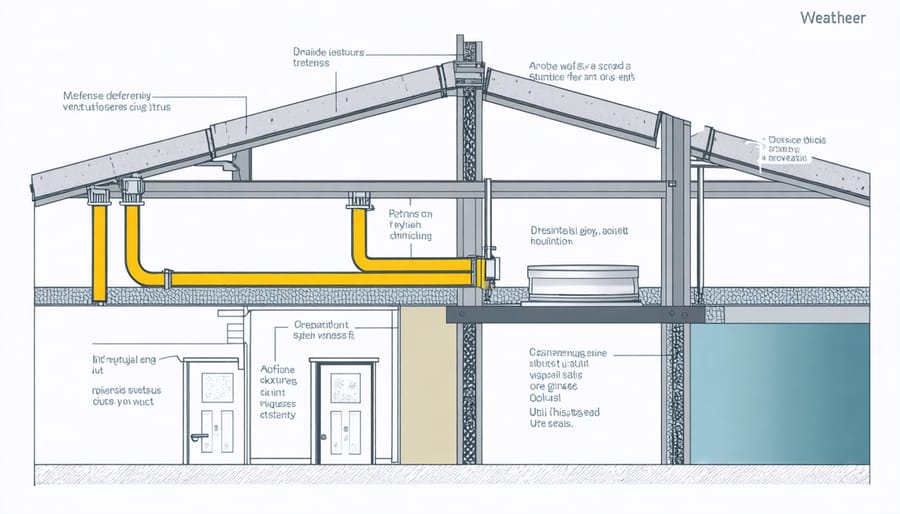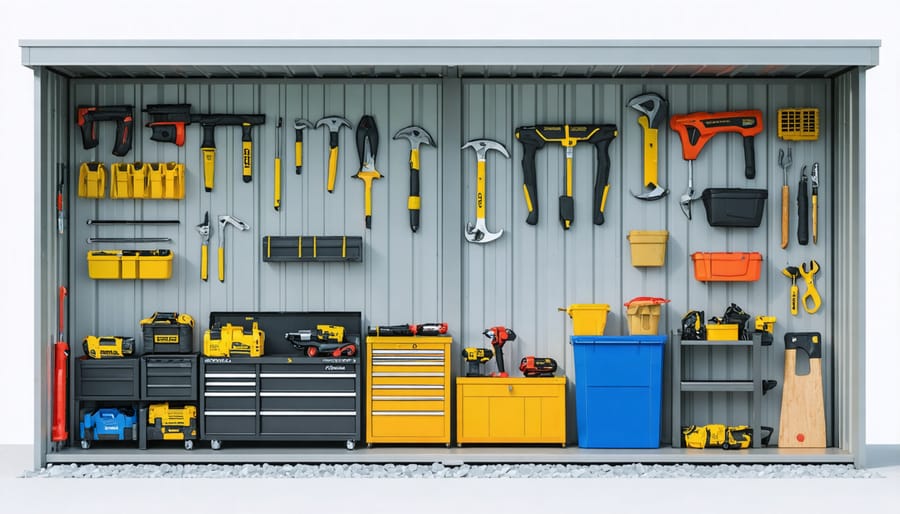Weather-Tough Storage That Keeps Your Outdoor Workspace Running Strong

Transform your outdoor storage from a weather-vulnerable weakness into a fortress of protection with today’s innovative weatherproof solutions. From specialized tool sheds to climate-controlled containers, modern storage options combine durability with smart design to safeguard valuable equipment and materials against nature’s harshest elements.
Every year, homeowners lose thousands of dollars to weather-damaged tools and equipment stored improperly outdoors. Whether you’re protecting power tools in a backyard workshop or securing construction materials on a job site, choosing the right weatherproof storage solution isn’t just about buying a box – it’s about investing in a system that works as hard as you do.
In this comprehensive guide, we’ll explore the most effective weatherproof storage options available today, from heavy-duty plastic containers to sophisticated modular systems. We’ll examine key features like water-resistant seals, UV protection, and ventilation design that separate exceptional storage solutions from basic shelters. Plus, we’ll share expert tips for maximizing storage space while ensuring your items remain accessible and protected year-round.
Don’t let unpredictable weather compromise your outdoor storage needs. Let’s discover how the right weatherproof solution can protect your investments while enhancing your outdoor workspace’s functionality.

Smart Material Choices for Weather-Ready Storage
High-Performance Plastics and Resins
Modern weather-resistant materials have revolutionized outdoor storage solutions, with high-performance plastics and resins leading the way. These innovative materials offer exceptional durability while maintaining an attractive appearance that complements your outdoor space.
Today’s resin storage solutions feature advanced UV inhibitors that prevent sunlight from breaking down the material, ensuring your storage unit won’t fade, crack, or become brittle over time. Many manufacturers use double-wall construction, creating an insulating air barrier that helps regulate internal temperature and prevents condensation from damaging stored items.
What makes these materials particularly impressive is their resistance to rust, rot, and pest infestations – common problems with traditional storage options. The molded designs are seamless, eliminating weak points where moisture might penetrate, while specially engineered polymers resist impacts and extreme temperature fluctuations without warping.
These modern plastics are also incredibly low-maintenance, requiring only occasional cleaning with soap and water to keep them looking fresh. Many come with built-in floor panels that elevate stored items away from ground moisture, providing an extra layer of protection for your belongings.
Treated Wood Solutions
Treated wood solutions offer a perfect blend of durability and natural aesthetics for outdoor storage. Pressure-treated lumber stands as the foundation of weather-resistant wooden storage, featuring chemical treatments that protect against moisture, insects, and decay. These structures can last 20+ years with proper maintenance, making them an excellent long-term investment.
Cedar and cypress naturally resist weather damage and insects, though they come at a premium price point. For enhanced protection, consider adding a water-resistant sealant every 2-3 years. This simple maintenance step significantly extends the life of your wooden storage solution while preserving its natural beauty.
For best results, elevate your wooden storage structure on concrete blocks or a gravel bed to prevent ground moisture from seeping upward. Installing proper ventilation and ensuring good drainage around the structure will further protect your investment. Many homeowners appreciate how treated wood structures can be customized with shelving, hooks, and organizational systems to match their specific storage needs.
Metal Storage Systems
Metal storage systems offer exceptional durability and weather resistance, making them a top choice for outdoor storage needs. Powder-coated steel units provide superior protection against rust and corrosion while maintaining an attractive appearance that complements any outdoor space. These storage solutions typically feature reinforced doors, weather stripping, and raised floors to keep contents dry and secure.
Galvanized metal options take weather protection a step further with their zinc coating that naturally resists rust and can withstand decades of exposure to the elements. Many modern metal storage systems come with integrated ventilation to prevent condensation buildup, while still maintaining a weathertight seal against rain and snow.
For maximum longevity, look for units with double-wall construction and overlapping seams. These features create an extra barrier against moisture while adding structural stability. Most metal storage solutions also include pre-drilled anchor points for secure installation on concrete pads or level ground, ensuring they stay put during strong winds and storms.
Essential Features for Weather Protection
Moisture Defense Systems
Effective moisture control is crucial to protect from weather damage and maintain the integrity of your outdoor storage space. A well-designed moisture defense system combines three essential elements: ventilation, drainage, and proper sealing.
Start with strategic ventilation placement. Install vents at both the peak and base of your storage structure to create natural airflow. This circulation helps prevent condensation buildup and keeps stored items dry. Consider adding adjustable vents that you can partially close during harsh weather while maintaining minimal airflow.
Proper drainage begins from the ground up. Ensure your storage solution sits on a slightly elevated foundation with a gentle slope away from the structure. Install gutters and downspouts to direct rainwater away from the base. For added protection, consider laying a bed of gravel around the perimeter to improve drainage and prevent water pooling.
Sealing techniques provide your final defense against moisture. Use high-quality weatherstripping around doors and windows, and apply silicone caulk to seal any gaps where moisture might enter. Pay special attention to corners and joints, as these are common entry points for water. For wooden structures, apply a water-resistant sealant every few years to maintain protection.
Remember to check these systems regularly, especially before and after severe weather events. Quick repairs to damaged seals or blocked drainage can prevent costly moisture-related problems down the line.

Access and Security Features
A robust access system is crucial for any weatherproof storage solution, starting with high-quality weather-sealed doors that create an airtight barrier against moisture and dust. Look for doors with rubber gaskets or weatherstripping that compress when closed, creating a reliable seal that keeps your belongings safe and dry.
Security features should include rust-resistant padlock hasps or built-in locking mechanisms designed to withstand outdoor conditions. Many modern storage solutions come with sophisticated electronic entry systems featuring keypad access or smartphone connectivity, allowing you to monitor and control access remotely.
For added protection, consider doors with multi-point locking systems that secure the door at several points along the frame. Heavy-duty hinges with weather-resistant coatings prevent sagging and ensure smooth operation even after years of exposure to the elements.
Don’t overlook the importance of proper door alignment – even the best weather seals won’t work if the door doesn’t close properly. Many quality storage solutions feature adjustable hinges that allow you to fine-tune the door’s position for optimal sealing and security.
Foundation and Elevation Solutions
A solid foundation is crucial for protecting your outdoor storage from water damage and structural issues. Start by selecting a level spot that’s slightly elevated from the surrounding ground to prevent water pooling. For the base, consider using concrete pavers or a concrete slab, which provide excellent stability and moisture resistance. If you’re working with a wooden platform, ensure it’s at least 6 inches above ground level and treated with weather-resistant materials.
Installing adjustable foundation piers can help maintain proper elevation and allow for future adjustments as the ground settles. Create a slight slope (about 1 inch per 8 feet) away from your storage structure to encourage water runoff. For areas with frequent rainfall, consider adding a French drain system around the perimeter.
When installing your storage solution, use pressure-treated lumber for any wood components that contact the ground. Place a moisture barrier between your foundation and storage unit to prevent dampness from seeping upward. If you’re in a flood-prone area, consider raising your storage unit an additional 12 inches and installing flood vents to protect your belongings during severe weather events.
Smart Organization for Weather Protection
Vertical Storage Strategies
When it comes to protecting your belongings from ground moisture while making the most of your available space, thinking vertically is key. To maximize storage space, start by installing sturdy wall-mounted shelving units at least 6 inches off the ground. This elevation creates a crucial barrier against rising damp and allows for better air circulation.
Consider installing adjustable track systems that can accommodate different shelf heights and configurations as your storage needs change. Heavy-duty brackets and rails made from powder-coated steel or aluminum offer excellent durability in humid conditions while supporting substantial weight.
For tools and gardening equipment, pegboards provide fantastic vertical organization while keeping items visible and accessible. Install clear plastic bins on upper shelves to protect smaller items while maintaining visibility. Remember to position frequently used items at eye level and heavier objects lower down for safety and convenience.
Make use of corner spaces by installing triangle-shaped shelves or rotating storage units. Add hooks beneath shelves for hanging items like garden hoses or extension cords, keeping them off the ground and tangle-free. For additional protection, consider using moisture-resistant shelf liners and storing items in weatherproof containers with secure lids.
Don’t forget about door space – over-the-door organizers and hooks can add valuable storage area without taking up floor space. This approach not only protects your belongings but also creates an organized, efficient storage system that’s easy to maintain.

Weather-Smart Layout Tips
Smart organization is your first line of defense against weather damage. Start by creating distinct zones within your storage space based on item sensitivity. Position weather-resistant items like plastic containers and metal tools near entry points, while keeping delicate electronics and moisture-sensitive materials toward the interior where they’re better protected.
Install shelving units at least 6 inches off the ground to prevent moisture absorption from floor contact. Use adjustable metal shelving rather than wood to avoid warping and create better airflow. Place frequently used items at eye level and reserve higher shelves for seasonal storage.
Consider vertical storage solutions to maximize space while minimizing ground contact. Wall-mounted pegboards and hook systems keep tools elevated and organized while allowing air circulation. For smaller items, clear plastic bins with secure lids work best – they’re waterproof and allow you to quickly identify contents without opening.
Create a “weather buffer zone” near entrances using moisture-absorbing mats and dehumidifiers. This transition area helps regulate humidity levels throughout your storage space. Use silica gel packets in containers storing sensitive items, and replace them regularly.
Label everything clearly with weather-resistant tags or markers, and maintain an inventory system that notes which items need extra protection. This organization method not only protects your belongings but also makes seasonal rotation and maintenance checks more efficient.
Maintenance Tips for Long-Term Protection
Seasonal Checkups
Regular seasonal inspections ensure your storage solutions remain weatherproof and functional throughout the year. In spring, check for winter damage and clear any debris from gutters and drainage systems. Inspect seals around doors and windows, and look for signs of water damage or mold growth. This is also an ideal time to evaluate your sustainable outdoor storage solutions for any needed upgrades.
Summer maintenance focuses on ventilation and pest prevention. Ensure proper airflow by cleaning vents and checking that all ventilation systems are working correctly. Look for signs of insect infestation and seal any small gaps or entry points.
Fall preparation is crucial for winter readiness. Clear leaves from the roof and gutters, check weatherstripping, and reinforce any weak spots in the structure. Apply weather sealant where needed and ensure doors and windows close properly.
Winter checks should focus on snow load management and moisture control. Remove snow accumulation from roofs promptly, and monitor for ice dam formation. Keep pathways clear for easy access, and check interior spaces regularly for condensation issues.
Remember to document any issues you find during these inspections and address them promptly to prevent more significant problems from developing.
Quick Fixes for Common Issues
Encountering storage issues due to weather? Here are some quick solutions to common problems that can help protect your belongings. For leaky roofs, apply weatherproof sealant to visible cracks and consider installing rubber roof strips along seams. If you notice condensation building up inside your storage unit, add a solar-powered vent or moisture-absorbing packets to regulate humidity levels.
For doors that stick during wet weather, apply silicone spray to the tracks and hinges, and ensure proper alignment by tightening loose screws. To prevent water seepage at the base, install rubber door sweeps and create a slight gradient away from the entrance for better drainage.
Rusty metal components can be treated with rust converter and protected with marine-grade paint. For mold prevention, spray affected areas with a vinegar solution and improve ventilation. If you’re dealing with pest intrusion through small gaps, use expanding foam sealant and install mesh screens over vents.
To protect items stored directly on the floor, use plastic pallets or shelving units with adjustable feet. For valuable items sensitive to temperature fluctuations, consider adding insulation panels to walls and ceiling, or using weather-resistant storage containers with rubber gaskets for extra protection.
Investing in quality weatherproof storage solutions is essential for protecting your valuable belongings and maintaining an organized outdoor space. Throughout this guide, we’ve explored various options, from heavy-duty plastic containers to weather-resistant metal cabinets and specialized outdoor storage sheds. Remember that successful outdoor storage depends on choosing materials specifically designed to withstand the elements, properly sealing and maintaining your storage units, and implementing smart organization systems.
By following the recommendations for proper installation, regular maintenance, and strategic placement, you can significantly extend the life of both your storage solutions and the items within them. Whether you’re storing garden tools, sports equipment, or seasonal decorations, the right weatherproof storage solution will save you money in the long run by preventing damage from moisture, UV rays, and temperature fluctuations.
Take time to assess your specific needs, available space, and local climate conditions before making your final choice. With proper planning and the right weatherproof storage solution, you can enjoy peace of mind knowing your belongings are protected year-round while maintaining a clean and organized outdoor living space.

